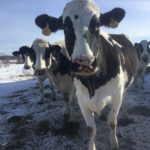Everyone was complaining about the cold last week. Sub zero temperatures for nearly two weeks isn’t just a polar vortex- it’s just plain miserable.
No matter how we try and make sure the cows are kept warm and dry-there are consequences to prolonged cold for dairy cattle. Here are tips below to help the cows recover faster.
1. Feed chelated minerals to boost immunity.
After a long bout of cold, immunity can run low. The cow regains her immunity over time, but the process can be slow. Use chelated minerals to speed it up.
2. Feed biotin to prevent and heal hoof (sand) cracks
Hoof cracks, also known as sand cracks occur when a cow is kept inside for long periods of time, usually during the cold. The use of lime to control moisture in the barn can dry out the hooves and cause cracks in the hooves. Biotin helps restore the flexibility of the hoof.
3. Try rumensin in the prefresh diet and for prefresh heifers.
Ketosis and fatty livers are very common after a cold bout of winter temperatures. The cow’s body mobilizes fat to use for energy-most often too much, flooding her system with ketones and in some cases, plugging the liver. According to studies rumensin can reduce the effect by 40%.
4. MultiminUse 90 or another trace mineral injectable for cows with high SCC.
Frozen teats and cold udders almost always end with mastitis. Frozen teats benefit from keeping the area soft-using an ointment or lotion. Pair that with Multimin to help boost her natural immunity until she can be treated.
5. Use a good toxin binder
Certain binders-ones that contain clay (bentonite) or charcoal can not only absorb toxins from molds, but can absorb toxins from dysentery and bad silage.
6. Use a footbath
Chances are, if the cows were in a free stall, they were walking on frozen manure. Frozen manure can be very sharp and scrape the hoof. This allows bacteria in and causes hoof rot and/or hairy warts to flare up. Start your foot bath as soon as possible.
